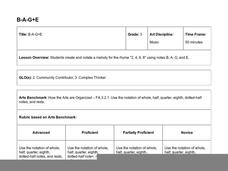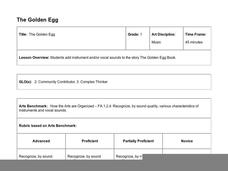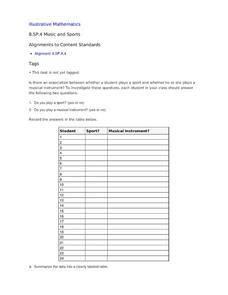Curated OER
Alicia Keys, Songs in A Minor
How do a person's musical preferences influence the way they compose music of their own? Learners analyze the sound and lyrics of Alicia Keys in relation to musicians that came before. Jazz, blues, and soul music from the past are shown...
SoundTree
Notating Friedrich von Schiller’s Theme to “Ode to Joy.”
To demonstrate their skills with traditional and computer-assisted notation, young musicians notate and perform the first eight measures of Friedrich von Schiller's theme to "Ode to Joy."
Curated OER
Kindergarten Music Lesson
Singing, clapping, moving up and down with the melody, it all sounds like a great music lesson. Kinder-musicians sing three different songs to practice memory, speaking, and movement skills. They'll move to the melody, build memory with...
Curated OER
Focus on Form
Young musicians discuss musical form found in the song, The Star Spangled Banner. They review their parts for the song then practice playing it as a group. Cross-curricular activity suggestions are included.
Curated OER
A Musical Accent Activity
Budding instrumentalists take on the task of reading accent marks and playing them correctly. They practice playing the provided rhythm or beat, focusing on emphasizing notes that have accents over them. The handout included provides...
Curated OER
Independent Harmonies
Independent harmonies, homophonic music, intervals, and melody are all part of music theory and practice. Prepare your budding musicians for the big time with these activities focused on playing with accompaniment. This lesson is...
Curated OER
Interpreting Choral Music
Budding musicians determine the differences in style between the various periods in choral music. They engage in a class discussion, read one of the suggested materials, then perform a choral piece from a specific time in history.
Hawaiʻi State Department of Education
B-A-G+E
Budding musicians discuss rhythmic notation and melody as they play a bar instrument or recorder. They use the notes B, A, G, and E to play a simple melody, and then they use those same four notes to turn a poem into a song. They play...
Hawaiʻi State Department of Education
The Golden Egg
Get ready for a musical story time! First your young musicians review musical dynamics as they listen to and discuss the pitch and sound of each instrument you play for them. Then they talk about special words (mostly verbs) in the book,...
Curated OER
Music and Sports
With so much talent in the classroom, do your musicians and athletes have related interests? This problem has your learners taking data from their classmates to decide whether there is an association between the two activities. The...
Civil War Trust
The Common Civil War Soldier
Imagine you are a soldier in the Civil War. What are you wearing? What do you need to carry with you? Examine the life of a person during the Civil War, from drummer boys to powder monkeys to musket-toting soldiers. Elementary learners...
Classics for Kids
"Mars" from The Planets
Gustav Holst's The Planets provide young musicians an opportunity to examine how composers can create a suite: a collection of smaller pieces grouped to explore a single topic. After listening to "Jupiter," they examine "Mars" in detail,...
Boston Symphony Orchestra
The Elements of Music—How do Composers Plan?
The introduction to Tchaikovsky's Swan Lake and the finale of his Symphony No. 4 provide young musicians with an opportunity to investigate the music elements composers employ to develop the themes they want to create. They compare the...
Concordia College Archives
Introduction and Student Inquiry
Introduce young musicians to the history of and different styles of music with an inquiry-based learning activity that asks them to play detectives to determine the similarities and differences among the sheet music found at a series of...
Historic New Orleans Collection
Exploring Primary Sources: Music in New Orleans
Looking for a new and exciting way to teach young historians the art of primary source analysis? Jazz up your lesson with a resource that asks class members to analyze photos, travel documents, and letters written by some of New Orleans'...
North Carolina Consortium for Middle East Studies
Using Drama to Address Social Justice Issues in School and the Community
Artists, musicians, and dramatists have long been the leaders in the quest for social justice. To gain an understanding of the power of the arts to address social issues, class members listen to a reading of Drew Daywalt's The Day the...
Smithsonian Institution
Spirits Across the Ocean: Yoruban and Dahomean Cultures in the Caribbean Brought by the Slave Trade
Much of Latin American music owes its origins to the slave trade. Peoples from the Yoruban and Dahomean cultures brought with them the distinctive rhythms, time signatures, and eighth note patterns that now characterize Caribbean music....
Smithsonian Institution
Braiding Rhythms: The Role of Bell Patterns in West African and Afro-Caribbean Music
Africans transported to the Caribbean as part of the transatlantic slave trade brought with them a rich tradition of music and dance. Four lessons teach young musicians the rumba clave rhythm, cascara rhythm, and the 6/8 bell patterns...
Smithsonian Institution
The Vocal Blues: Created in the Deep South of the U.S.
Bring the sounds of the deep South vocal blues to the classroom with a Smithsonian Folkways lesson. In preparation, scholars listen to and count the 12 bar blues patterns in several works and identify the I, II, IV, and V chords as well...
Smithsonian Institution
Jamaican Song, Dance, and Play: Experiences with Jamaican Musical Traditions
Young musicians experience song, dance, and play of the Jamaican culture. Scholars listen for and recreate beats, they play tunes, make up original dances, and play a game that challenges pupils to pass stones to a specific beat.
John F. Kennedy Center
Musical Harlem: How Is Jazz Music Reflective of the Harlem Renaissance?
Bring jazz music and the Harlem Renaissance to light with a lesson that challenges scholars to research and create. Pupils delve deep into information materials to identify jazz terminology, compare types of jazz and jazz musicians,...
Curated OER
The Blues . Music Education
What ultimately influences a musician's creations? Is it the time in which he/she lives, his/her personal experiences, the music of the time and previous times, or the image the artist hopes to convey? This lesson explores these...
Curated OER
Cut and Paste Biographies
Students explore the influence of African-American artists, writers, and musicians on American culture. After researching different figures in these areas, they create collages representing each person's life and legacy.
Curated OER
A Place for Me in the Field of Music
Second graders listen to interviews with career musicians. They, in groups, present to classmates the life, music, inspiration, and goals of a favorite composer, performer, or group.
Other popular searches
- Bremen Town Musicians
- Famous Black Musicians
- Jazz Musicians
- Black Musicians
- Blues and Jazz Musicians
- Biographies of Musicians
- Musicians of Bremen
- Musicians Roles in Society
- African American Musicians
- Composers Musicians
- 1940 Black Musicians
- New Orleans Musicians

























